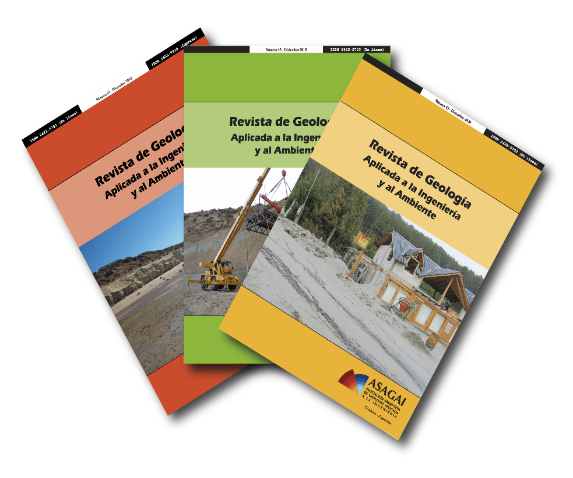Geophysical techniques for the detection of suffusion: review of the literature
Keywords:
geophysics, dam, pipingAbstract
The occurrence of tragedies by rupture of reservoirs and dams has prompted debates about the search for safer monitoring mechanisms and early detection. From this perspective, geotechnical engineering has progressively explored alternative methods to broaden the understanding of the occurrence of damage in dams. Geophysics emerges as an alternative methodology in overcoming these challenges, given its practicality in obtaining data, resolution capacity, and cost/benefit ratio, and above all by to using non-invasive methods. Thus, this research aims to present the potential of geophysical methodology in the evaluation of geotechnical problems associated with internal erosion, namely and piping in dams. To this end, a literature review was conducted about the geophysical methodologies that have successful identified piping in dam structures over the years. In addition, the theoretical aspects concerning each method will be presented, as well as the advantages and disadvantages in piping detection. Considering the versatility of the geophysical methods presented, it is believed that the increment of geophysical information in geotechnical monitoring can contribute decisively to the early detection of piping.
References
Antoine, R., Fauchard, C., Fargier, Y. & Durand, E. (2015). Detection of Leakage Areas in an Earth Embankment from GPR Measurements and Permeability Logging. International Journal of Geophysics, 2015, 1–9. https://doi.org/10.1155/2015/610172
Bièvre, G., Lacroix, P., Oxarango, L., Goutaland, D., Monnot, G., & Fargier, Y. (2017). Integration of geotechnical and geophysical techniques for the characterization of a small earth-filled canal dyke and the localization of water leakage. Journal of Applied Geophysics, 139, 1–15. https://doi.org/10.1016/j.jappgeo.2017.02.002
Bolton Seed, H., & Duncan, J. M. (1987). The failure of Teton Dam. Engineering Geology, 24(1–4), 173–205. https://doi.org/10.1016/0013-7952(87)90060-3
Bovi, R. C., Moreira, C. A., Rosolen, V. S., Rosa, F. T. G., Furlan, L. M., & Helene, L. P. I. (2020). Piping process: Genesis and network characterization through a pedological and geophysical approach. Geoderma, 361, 114101. https://doi.org/10.1016/j.geoderma.2019.114101
Braga, A. C. O. (2016). Geofísica Aplicada: métodos geoelétrico em hidrologia. São Paulo: Editora Oficina de Textos.Brasil. (2002). Manual de segurança e inspeção de barragens. Ministério da Integração Nacional.
Butler, D. K. (1984). Microgravimetric and gravity gradient techniques for detection of subsurface cavities. Geophysics, 49(7), 1084–1096. https://doi.org/10.1190/1.1441723
Camarero, P. L., Moreira, C. A., & Pereira, H. G. (2019). Analysis of the Physical Integrity of Earth Dams from Electrical Resistivity Tomography (ERT) in Brazil. Pure and Applied Geophysics, 176(12), 5363–5375. https://doi.org/10.1007/s00024-019-02271-8
Cardarelli, E. (2002). Ray tracing in elliptical anisotropic media using the linear traveltime interpolation (LTI) method applied to traveltime seismic tomography. Geophysical Prospecting, 50(1), 55–72. https://doi.org/10.1046/j.1365-2478.2002.00297.x
Cardarelli, E., Cercato, M., De Donno, G., & Di Filippo, G. (2014). Detection and imaging of piping sinkholes by integrated geophysical methods. Near Surface Geophysics, 12(3), 439–450. https://doi.org/10.3997/1873-0604.2013051
Cho, I.-K., & Yeom, J.-Y. (2007). Crossline resistivity tomography for the delineation of anomalous seepage pathways in an embankment dam. Geophysics, 72(2), G31–G38. https://doi.org/10.1190/1.2435200
Coker, F. (2018). Geophysical Assessment of Subsurface Soil Conditions Using Capacitively Coupled Resistivity. University of Oklahoma.
Davis, J. L., & Annan, A. P. (1989). Ground Penetrating Radar For High Resolution Mapping Of Soil And Rock Stratigraphy. Geophysical Prospecting, 37(5), 531–551. https://doi.org/https://doi.org/10.1111/j.1365-2478.1989.tb02221.x
Dutta, N. P. (1984). Seismic refraction method to study the foundation rock of a dam. Geophysical Prospecting, 32(6), 1103–1110. https://doi.org/10.1111/j.1365-2478.1984.tb00757.x
Eikmeier, C. (2014). Emprego do método MASW (Multichannel Analysis of Surface Waves) em área urbana: um estudo na cidade de São Paulo. Simpósio de Iniciação Científica Do IAG-USP, 132. https://doi.org/10.13140/RG.2.2.29710.36161
Ezersky, M., Bruner, I., Keydar, S., Trachtman, P., & Rybakov, M. (2006). Integrated study of the sinkhole development site on the Western shores of the Dead Sea using geophysical methods. Near Surface Geophysics, 4(5), 335–343. https://doi.org/10.3997/1873-0604.2006007
Fontenelle, M., Alexandre, M., & Yago, M. (2017). Avaliações de risco em barragens: estudo de caso da barragem Malcozinhado no nordeste brasileiro. Revista Eletrônica de Engenharia Civil, 14(1), 22.
Gallas, J. D. F. (2005). O método do potencial espontâneo (SP): uma revisão sobre suas causas, seu uso histórico e suas aplicações atuais. Revista Brasileira de Geofísica, 23(2), 133–144. https://doi.org/10.1590/S0102-261X2005000200003
Geometrics. (2021). OhmMapper Capacitively Coupled Resistivity System. Alphageofisica. http://www.geometrics.com/OhmMapper/ohmmap.html
Henriet, P., Schittekat, J., & Heldens, P. (1983). Borehole Seismic Profiling and Tube Wave Applications in a Dam Site Investigation. Geophysical Prospecting, 31(1), 72–86. https://doi.org/10.1111/j.1365-2478.1983.tb01042.x
Johansson, S., & Dahlin, T. (1996). Seepage monitoring in an earth embankment dam by repeated resistivity measurements. European Journal of Environmental and Engineering Geophysics, 1(3), 229–247.
Kearey, P., Brooks, M., & HILL, I. (2009). Geofísica de exploração. (3°). Oficina de Textos.
Kim, H.-J., Park, J.-M., & Shin, J.-H. (2019). Flow behaviour and piping potential at the soil–structure interface. Géotechnique, 69(1), 79–84. https://doi.org/10.1680/jgeot.17.T.020
Kirsch, R., & Yaramanci, U. (2006). Geophysical characterisation of aquifers. In Groundwater geophysics: A tool for hydrogeology (pp. 439–457). Springer. https://doi.org/10.1007/3-540-29387-6_15
Loke, M. (2016). Tutorial: 2-D and 3-D Electrical Imaging Surveys. Geotomo Software Company.
Luo, D., Goodin, D. G., & Caldas, M. M. (2019). Spatial–Temporal Analysis of Land Cover Change at the Bento Rodrigues Dam Disaster Area Using Machine Learning Techniques. Remote Sensing, 11(21), 2548. https://doi.org/10.3390/rs11212548
Martínez-Moreno, F. J., Galindo-Zaldívar, J., Pedrera, A., González-Castillo, L., Ruano, P., Calaforra, J. M., & Guirado, E. (2015). Detecting gypsum caves with microgravity and ERT under soil water content variations (Sorbas, SE Spain). Engineering Geology, 193, 38–48. https://doi.org/10.1016/j.enggeo.2015.04.011
Masi, M., Ferdos, F., Losito, G., & Solari, L. (2020). Monitoring of internal erosion processes by time-lapse electrical resistivity tomography. Journal of Hydrology, 589, 125340. https://doi.org/10.1016/j.jhydrol.2020.125340
Medeiros, W. E., & Lima, O. A. L. (1999). Origem do potencial elétrico espontâneo em rochas cristalinas fraturadas e sua utilização na locação de poços. Revista Brasileira de Geofisica, 17(2–3), 113–115. https://doi.org/10.1590/s0102-261x1999000200001
Muguio, M., Faggion, P., Veiga, L., Nadal, C., Cruz, W., Soares, M., & Figueira, I. (2017). Avaliação Da Anomalia Da Gravidade Na Região Do Barramento Da Usina Hidrelétrica De Mauá. Boletim Paranaense de Geociências, 73(1), 55–62. https://doi.org/10.5380/geo.v73i1.49105
Netto, L. G., Filho, W. M., Paes, R. A. S., & Coura, M. M. (2018). Análise de Fluxo No Interior de Barragens de Terra A Partir do Método do Potencial Espontâneo (SP). 16° Congresso Brasileiro de Geologia de Engenharia e Ambiental, 1–7.
Ogilvy, A. A., Ayed, M. A., & Bogoslovsky, V. A. (1969). Geophysical Studies Of Water Leakages From Reservoirs. Geophysical Prospecting, 17(1), 36–62. https://doi.org/10.1111/j.1365-2478.1969.tb02071.x
Oh, S., & Sun, C.-G. (2008). Combined analysis of electrical resistivity and geotechnical SPT blow counts for the safety assessment of fill dam. Environmental Geology, 54(1), 31–42. https://doi.org/10.1007/s00254-007-0790-y
Panthulu, T. V., Krishnaiah, C., & Shirke, J. M. (2001). Detection of seepage paths in earth dams using self-potential and electrical resistivity methods. Engineering Geology, 59(3–4), 281–295. https://doi.org/10.1016/S0013-7952(00)00082-X
Park, C. B., Miller, R. D., Xia, J., & Ivanov, J. (2007). Multichannel analysis of surface waves (MASW)—active and passive methods. The Leading Edge, 26(1), 60–64. https://doi.org/10.1190/1.2431832
Porsani, J. L. (1999). Ground penetrating radar (GPR) : proposta metodológica de emprego em estudos geológico-geotécnicos nas regiões de Rio Claro e Descalvado-SP. Universidade Estadual Paulista.
Pueyo Anchuela, Ó., Frongia, P., Di Gregorio, F., Casas Sainz, A. M., & Pocoví Juan, A. (2018). Internal characterization of embankment dams using ground penetrating radar (GPR) and thermographic analysis: A case study of the Medau Zirimilis Dam (Sardinia, Italy). Engineering Geology, 237, 129–139. https://doi.org/10.1016/j.enggeo.2018.02.015
Rahimi, S., Moody, T., Wood, C., Kouchaki, B. M., Barry, M., Tran, K., & King, C. (2019). Mapping Subsurface Conditions and Detecting Seepage Channels for an Embankment Dam Using Geophysical Methods: A Case Study of the Kinion Lake Dam. Journal of Environmental and Engineering Geophysics, 24(3), 373–386. https://doi.org/10.2113/JEEG24.3.373
Reynolds, J. (2011). An Introduction to Applied and Environmental Geophysics. Wiley BlackWell.
Richards, K. S., & Reddy, K. R. (2007). Critical appraisal of piping phenomena in earth dams. Bulletin of Engineering Geology and the Environment, 66(4), 381–402. https://doi.org/10.1007/s10064-007-0095-0
Schimschal, U. (1981). The relationship of geophysical measurements to hydraulic conductivity at the brantley damsite, New Mexico. Geoexploration, 19(2), 115–125. https://doi.org/10.1016/0016-7142(81)90024-7
Sentenac, P., Benes, V., & Keenan, H. (2018). Reservoir assessment using non-invasive geophysical techniques. Environmental Earth Sciences, 77(7), 293. https://doi.org/10.1007/s12665-018-7463-x
Sjödahl, P., Dahlin, T., & Johansson, S. (2005). Using resistivity measurements for dam safety evaluation at Enemossen tailings dam in southern Sweden. Environmental Geology, 49(2), 267–273. https://doi.org/10.1007/s00254-005-0084-1
Sjödahl, P., Dahlin, T., Johansson, S., & Loke, M. H. (2008). Resistivity monitoring for leakage and internal erosion detection at Hällby embankment dam. Journal of Applied Geophysics, 65(3–4), 155–164. https://doi.org/10.1016/j.jappgeo.2008.07.003
Wang, F., Okeke, A. C.-U., Kogure, T., Sakai, T., & Hayashi, H. (2018). Assessing the internal structure of landslide dams subject to possible piping erosion by means of microtremor chain array and self-potential surveys. Engineering Geology, 234, 11–26. https://doi.org/10.1016/j.enggeo.2017.12.023
Xu, X., Zeng, Q., Li, D., Wu, J., Wu, X., & Shen, J. (2010). GPR detection of several common subsurface voids inside dikes and dams. Engineering Geology, 111(1–4), 31–42. https://doi.org/10.1016/j.enggeo.2009.12.001
Zhu, W., Jia, S., Devineni, N., Lv, A., & Lall, U. (2019). Evaluating China’s Water Security for Food Production: The Role of Rainfall and Irrigation. Geophysical Research Letters, 46(20), 11155–11166. https://doi.org/10.1029/2019GL083226
Downloads
Published
Issue
Section
License
Copyright (c) 2022 Cleber de Jesus Santos Cleber, Jefferson de Lima Picanço

This work is licensed under a Creative Commons Attribution-NonCommercial-ShareAlike 4.0 International License.
Attribution - Non-Commercial - Share Alike (by-nc-sa): No commercial use of the original work or any derivative works is permitted, distribution of which must be under a license equal to that governing the original work.










